Advanced Micro Devices Inc. (NYSE: AMD) has been a very challenged company for years. The company has made some progress in video and graphics processors, but the effort so far in personal computers (PCs) has been slow enough that you might wonder if Intel Corp. (NASDAQ: INTC) has been slowing down its own PC processor lead just to avoid being accused of being a true monopoly.
The biggest question is what lies ahead for AMD. Just this week 24/7 Wall St. wondered whether AMD could conceivably go to zero. While that was not meant as any immediate death sentence, we always try to show both sides of the coin when it comes to controversial companies.
According to Wells Fargo’s David Wong, AMD is still rated as Outperform. Wong also has a valuation range of $3.00 to $3.50. If Wong’s upper-end of that valuation range comes about, AMD could be worth 50% higher than the $2.30 current share price. Wong has many caveats and concerns, but the effort is again to show both sides of the coin.
The note showed that AMD’s chips have twice the battery life of its previous line of processors, along with other upsell claims. The note also said:
AMD claims that the chips boast twice the battery life of its previous line of Kaveri processors, provide the world’s first High Efficiency Video Coding (HEVC) hardware decode support for notebooks, are AMD’s first Heterogeneous Systems Architecture (HSA) 1.0 compliant design, and represent the first ARM TrustZone capable high-performance APUs.
Like Intel, AMD has suffered from the continued decline in PC shipments. However, Intel’s considerably larger size gives it a pricing edge and has allowed it to weather this tough environment much better than AMD, which has struggled to turn a profit for the past few years. In fact, its net income has not been in the black since 2011. This is reflected in its stock price, which is down more than 42% over the past year and is hovering near the all-time low of $2.14.
ALSO READ: Deutsche Bank’s 3 Top Tech Stocks to Buy Before the Market Corrects
The company’s poor performance over the past few years has eaten into its balance sheet. Between 2011 and 2014, the company’s total cash fell to $1.040 billion from $1.765 billion. Until recently, it has managed to keep its cash reserves above $1 billion, but as of the latest quarter, these dropped by $134 million to $906 million, which can be seen as another red flag. At the same time, its debt has risen by $56 million to $2.27 billion. According to Yahoo! Finance, its total debt to equity ratio is now at an incredible 13,341.
According to Wells Fargo:
AMD has announced the release of its 6th generation 28nm A-Series Carrizo notebook SoC (system on chip) APUs (accelerated processing units), which feature up to 12 cores (4 Excavator CPU [central processing unit] + 8 GPU [graphics processing unit]) and use AMD’s Graphics Core Next Architecture on an FP4 package. Notebooks featuring the processors are expected to become available from original equipment manufacturers (OEMs) starting in June. This release follows AMD’s May 28th release of its Godavari family of desktop APUs and the company’s launch of its Carrizo-L lower power notebook chips in early May. We view today’s release as representative of steady execution by AMD of its appropriately modest PC (personal computer) processor roadmap.
ALSO READ: 5 Key Analyst Stock Picks With 50% to 100% Upside
Wells Fargo’s understanding from websites such as WCCF Tech is that AMD might eventually add more SKUs to its lineup. Although this is highly technical, these SKUs might include:
PRO FX-8800B; A6-8500P; PRO A10-8700B; PRO A8-8600B; PRO A6-8500B; RX-418GD (perhaps quad-core Merlin Falcon embedded SoCs with Radeon HD 10000 graphics, 4MB of shared L2 cache, 64-bit dual channel DDR3 (Double Data Rate 3) memory controller, and an ARM security processor); and RX-216GD (perhaps quad-core Merlin Falcon embedded SoCs with Radeon HD 10000 graphics, 4MB of shared L2 cache, 64-bit dual channel DDR3 memory controller, and an ARM security processor).
The firm does mention some company-specific risks in its report, which include the fact that AMD has yet to clearly demonstrate an ability to stabilize its sales and reduce its losses. Sector risks include uncertainty as to what long-term secular growth might be.
Wells Fargo gave its investment thesis as:
Although AMD has substantial risks associated with falling sales and continuing losses, we think the company has valuable expertise in microprocessor and graphics circuit design.
Shares of AMD were down 0.2% at $2.30 with two hours left in Wednesday’s trading session, in a 52-week trading range of $2.14 to $4.80. The stock has a consensus analyst price target of $2.52.
ALSO READ: 5 More Semiconductor Merger Candidates After Altera
Thank you for reading! Have some feedback for us?
Contact the 24/7 Wall St. editorial team.





